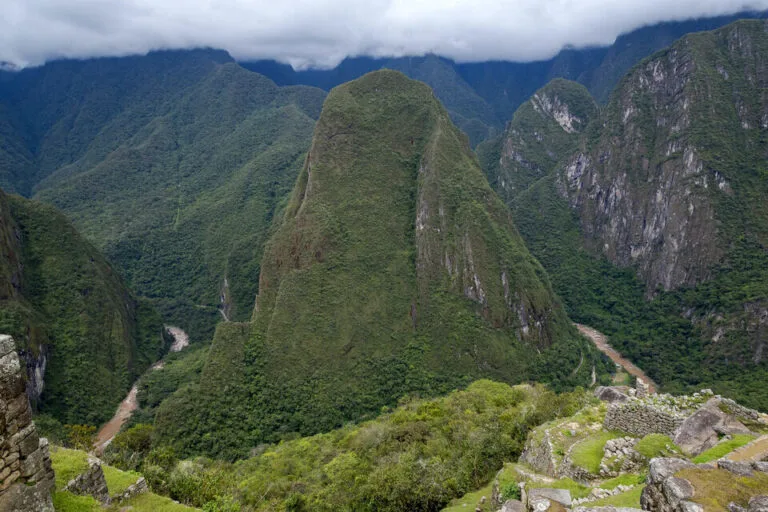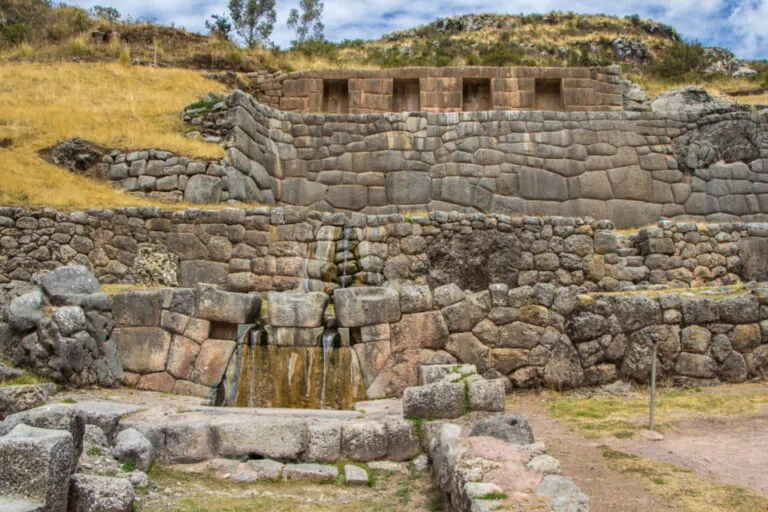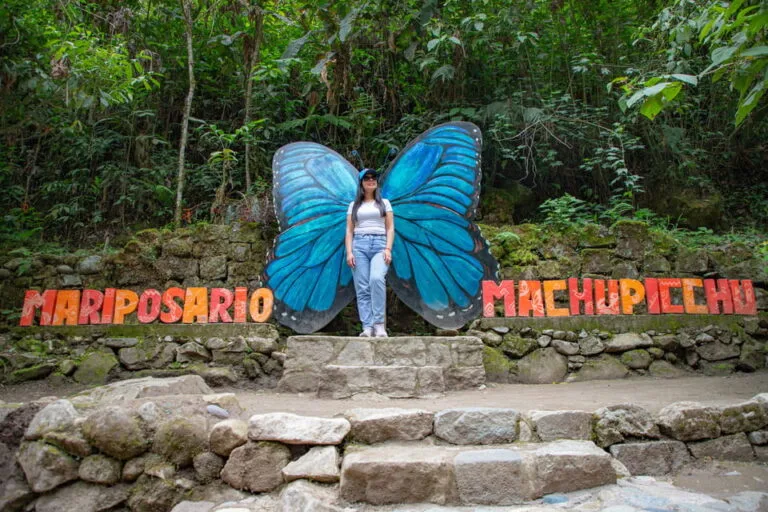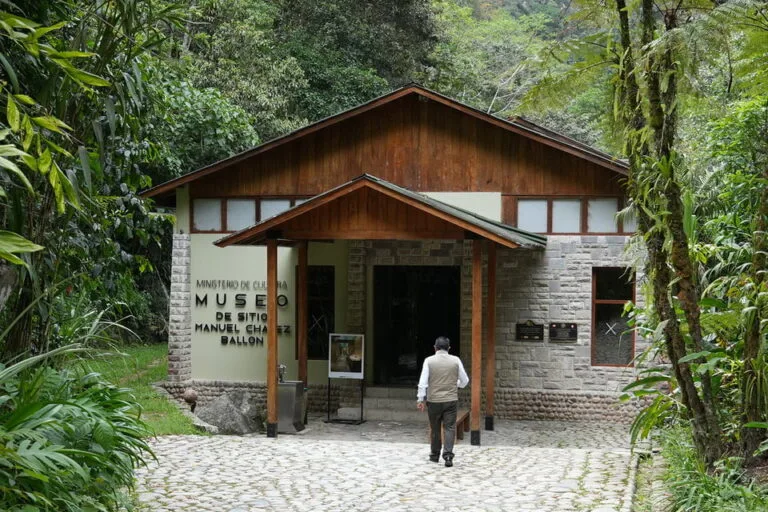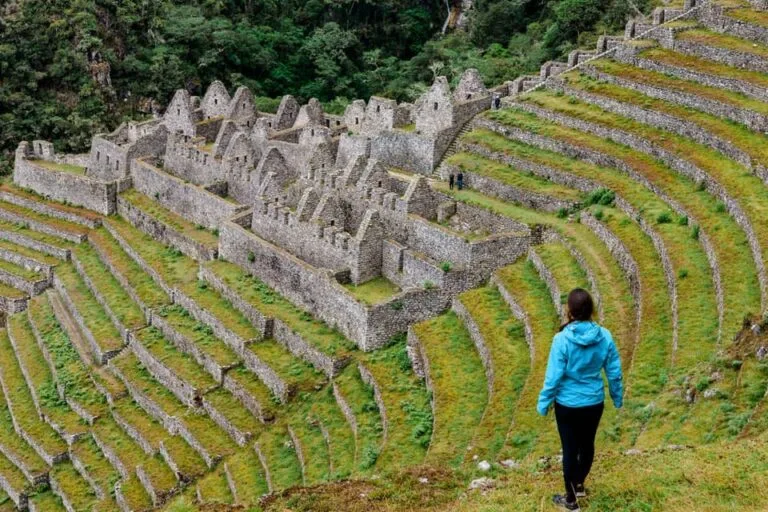Moray is different from other archaeological places in Peru’s Sacred Valley. Instead of temples or forts, it has these really cool circular farming terraces. These big earthworks are dug into a natural dip in the land, and they sit over 3,500 meters high. People have been curious and debating about them ever since they were found again. When you visit, you’re seeing how the Andeans were clever with their environment and how important farming was for them up in the mountains.
The Setting: Where and What Moray Looks Like
Moray is about 50 kilometers northwest of Cusco and around 7 kilometers west of Maras. It’s on a plateau above the Urubamba Valley, sitting between 3,450 and 3,600 meters high. The area has rolling hills and views of far-off snowy peaks like Chicon and Veronica. You can get there by dirt roads from Maras or paved roads from bigger towns nearby. Most folks visit as part of tours that also check out the Maras salt flats.
The main thing to see at Moray is this set of circular terraces in three big holes in the ground. The biggest one is about 220 meters wide and goes down 30 meters below the surface. Walking around the top or going down gives you different views of how big and well-designed it is. Unlike other places around, there aren’t big walls or carved stones. It’s all about the soil, the little climates they created, and trying out different crops.
Origins: History and Archaeology
People say Moray was built during the Inca times, mostly between the late 1400s and early 1500s, when Pachacuti and his successors were around. Archaeologists have found that they built the terraces in different stages, and maybe even cultures before the Incas used the natural sinkholes. But most of what you see now—the nice limestone walls, smart irrigation canals, and stairways—are classic Inca work.
Moray first got mentioned in modern times by an American explorer, Victor von Hagen, in the early 1900s, though local farmers always knew about it. Serious digging started in the late 1930s with Spanish-Peruvian archaeologist Luis E. Valcárcel. Since then, they’ve been studying soil layers, buildings, and plant remains to figure out how Moray was used. They’ve found pottery pieces, stone tools, clay-lined irrigation channels, and pollen from crops like corn, quinoa, and some Andean tubers.
Agricultural Lab: Purpose and New Ideas
Archaeologists mostly think that Moray was an agricultural testing place, not a religious or living space. Each terrace has its own little climate because of how much sun, soil, and humidity it gets, plus the protection from wind by the sloping walls and different heights.
Temperatures from the bottom to the top can be 5–7°C (9–13°F) different, creating conditions like those found across various heights in the Andes. By moving crops up or down the terraces, Inca farmers could see which ones grew best in certain climates.
Research by Peruvian scientists in the late 1900s confirmed that Moray’s terraces were used for selective breeding and crop adaptation. Different types of corn were probably grown together to test how they handled drought or frost. They also might have experimented with potatoes, oca, quinoa, and beans—all important Andean foods with many varieties adapted to specific areas.
Inca Farming: Techniques Seen in Moray
What makes Moray special isn’t just the terraces but how they’re built—each ring has strong stonework with channels for water drainage and irrigation. The walls lean in slightly to prevent collapsing after heavy rain, and the ground was layered with gravel for water filtering before hitting thick clay below.
The Incas were some of the first to use terrace farming on a big scale, which they needed because of the steep land and unpredictable weather in highland Peru. At Moray, this knowledge became like a science: soils were sometimes brought from far away to test; water was managed through stone aqueducts fed by seasonal springs; the deep terraces protected young plants from sudden cold snaps.
Even though we don’t know every detail—since there aren’t many written records from before the Spanish came—similar farming methods are still used by communities around Cusco, where they grow crops on terraced fields called “andenes.” The ideas seen at Moray are being used today to save native seeds as climate change becomes a bigger threat.
Cultural Meaning: Symbolism and Rituals
Though mainly practical, Moray might have also had symbolic importance in Inca beliefs. Circular shapes often relate to ideas of time cycles or Pachamama (Earth Mother). Some experts think there might have been ceremonies here to honor gods of fertility or good harvests—an idea supported by offerings found during digs, like ceramic pots with seeds or tiny figurines.
However, there’s no proof that Moray was a major religious place like Qorikancha or Ollantaytambo. It seems to have been more about practical things: improving staple crops to feed people, expanding the empire into different areas, and training expert “agronomists” who ran other farming spots in the Inca Empire.
Stories from local Quechua families support this dual view—respecting the ancient knowledge shown at places like Moray while also highlighting their current importance for survival in tough climates.
Visiting Moray: What You’ll Find Today
A visit to Moray offers more than just taking pictures—it’s a chance to think about land use from a long time ago. When you arrive, you can walk along trails that go around each depression; there are info panels in Spanish and English explaining the key features.
Local guides from tourism groups tell you all about how it was built, the farming cycles, and current conservation work. If you’re more of a solo explorer, you can carefully go down the paths between terrace rings to feel the temperature changes yourself.
- Entry Fees: You get in with the “Boleto Turístico del Cusco” (Cusco Tourist Ticket), which covers most main archaeological sites in the area.
- Facilities: There are basic restrooms at the entrance, but no restaurants; the nearby town of Maras has spots to eat.
- Season: The dry season (May–September) brings sunny mornings, but it can get windy or chilly in the afternoons.
- Tours: Many agencies combine Moray with the Maras salt flats on half-day trips starting from Cusco or Urubamba.
- Sustainability: Local authorities and the Ministry of Culture work together on stabilization projects—visitors are asked to stay on marked trails to prevent erosion.
Common Myths: Clearing Up Misunderstandings about Moray
Even though Peruvian experts have studied Moray since the mid-1900s, people still get things wrong about it online and even in some tours. One common myth says Moray was an alien landing spot because of its perfect shape—there’s no real evidence for that.
Another mistake is thinking Moray was mainly for ceremonies rather than experiments. While ritual might have been a secondary part (as with much of Inca life), the real evidence shows it was mostly for practical farming research.
Some older books suggest that each terrace ring was linked to a separate ethnic group’s efforts, but there’s no proof in digs or historical texts. Instead, it’s more accurate to say state-employed experts coordinated activities at Moray under imperial supervision as part of broader food security efforts.
The Bigger Picture: Andean Farming Science Beyond Moray
Moray’s fame can overshadow similar experiments done elsewhere in the Inca Empire. Other places near Pisac or Ollantaytambo show similar, though less dramatic, examples of terrace design for microclimates; some ruins higher up have rare cold-resistant potato varieties still grown by local farmers.
Today, agronomists are looking at ancient techniques from places like Moray to help when monoculture hurts biodiversity or when climate change messes up usual farming schedules. For example, indigenous-run cooperatives around Cusco use traditional seed banks, inspired by archaeological discoveries.
International groups like CIP (International Potato Center – CIP Lima) work with Quechua-speaking communities to protect genetic variety—a process echoing insights first seen in Andean terraces centuries ago.
Preserving the Past: Conservation Challenges at Moray
Keeping Moray balanced between tourism and conservation is a constant challenge for Peruvian officials. Natural things like rain can cause landslides on the terrace slopes if drainage systems get clogged—crews have to regularly clear debris from old canals and find the right stones for repairs.
A lot of foot traffic has compacted some paths over time, affecting grass cover that stabilizes the earth between rings. To lessen damage without closing off access, new wooden walkways were put in sensitive areas starting in 2015.
Research teams often check vegetation on unexcavated parts using drone photos—a recent project by Universidad Nacional de San Antonio Abad del Cusco combined aerial mapping with soil sampling to watch erosion rates year-over-year. Regional workshops keep training local youth in restoration skills specific to high-altitude archaeology so the expertise stays within the community long-term.
The Role of Local Communities Today
Nearby villages like Maras partly rely on income from tourists visiting Moray, adding to their lives based on potato farming or small-scale dairy herding. Seasonal festivals celebrate both old traditions and Catholic feast days—but pride especially shines for sites like Moray, which show off indigenous skill.
Community groups are directly involved in tourist management decisions through consultation committees set up by regional laws since 2007; these groups choose members for trail maintenance contracts or artisan stalls near parking areas. Local schools have added lessons about Moray into their teaching, so kids learn both about conservation and the family stories linked to their ancestors’ achievements. Sometimes there are disagreements about sharing income fairly or land-use boundaries, but these are usually sorted out in bilingual meetings with Quechua elders and local officials from Maras. Ongoing teamwork ensures that visitors see not just a preserved monument but also a lively cultural continuity rooted in today’s Andean life.
A Lasting Impact: Lessons from Moray’s Experiments
Not many archaeological sites show the link between environment and culture better than Moray. As people worldwide get more interested in sustainable farming—and the loss of crop diversity becomes a bigger problem—the story told by Moray’s terraces is now relevant beyond just Peru. In recent times, scientists visiting Moray have looked at soil layers to find clues about carbon storage potential or organic fertilizer use—a sign of how past methods still help with future solutions. Some workshops now invite international students along with local school groups for hands-on learning using traditional planting tools (“chaquitaclla”) under the guidance of master farmers trained in both indigenous knowledge and modern science curricula made by NGOs active around Urubamba Valley. Understanding that innovation can come from watching closely over generations—not just from big tech changes alone—is maybe Moray’s most important lesson, not just for Peruvians but for anyone interested in global food systems today.
Frequently Asked Questions
- Can you visit Moray on your own without a guide?
You can go to Moray by yourself by hiring a private vehicle or getting a taxi from nearby places like Maras or Urubamba. While tours give you background info on history and purpose, the signs at the site have basic details if you prefer exploring on your own. - Are drones allowed at Moray?
Generally, drones aren’t allowed for fun at archaeological sites managed by Peru’s Ministry of Culture unless you get written permission for research first. Flying drones without a license might lead to fines or having them taken away. - How accessible is Moray for people with limited mobility?
The main viewpoint near the entrance has ramps for wheelchairs or those with mobility challenges. But going down between terrace levels involves uneven stone steps without handrails. - What crops are grown near Moray now?
The fields around the protected area grow potatoes (many native kinds), barley, fava beans (“haba”), wheat brought during colonial times—and sometimes quinoa—on rotation schedules that are common in highland Cusco farms. - Are there local markets selling products related to ancient crops studied at Moray?
The town of Maras has regular markets where you can find locally grown potatoes—including some rare heirloom types—as well as regional tubers like oca and mashua. Sometimes vendors sell handwoven textiles with designs inspired by Moray’s circular terraces.



